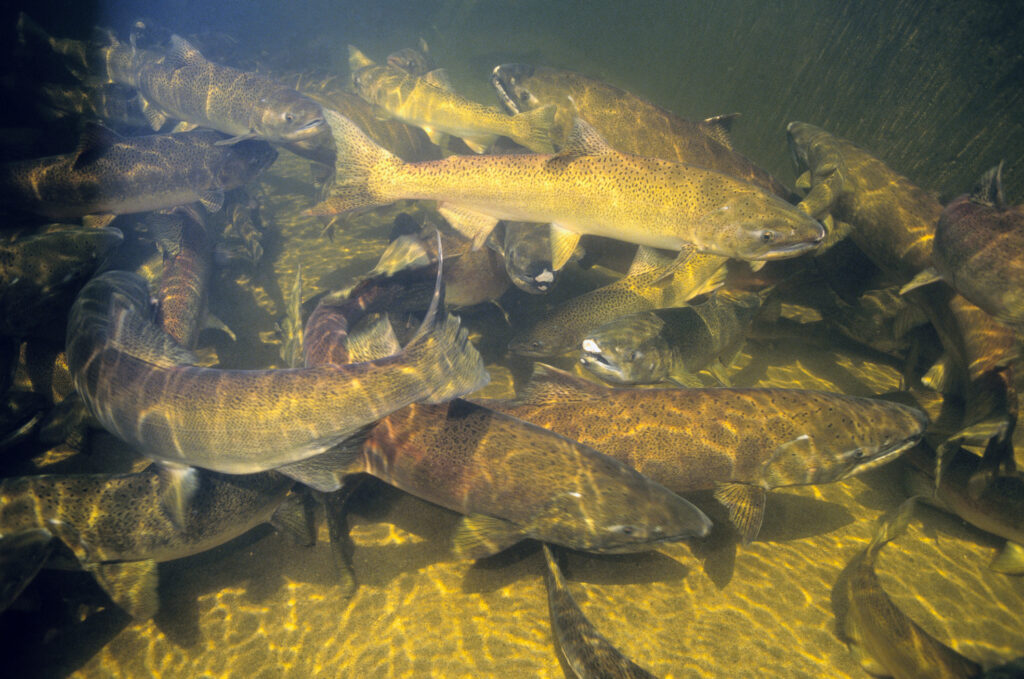In a landmark development, the White House has brokered a historic agreement aimed at revitalizing salmon populations in the Pacific Northwest. This groundbreaking deal, which could potentially bring an end to a protracted legal battle with tribes, involves a significant financial commitment of $300 million towards salmon restoration projects. In this blog post, we will delve into the details of this agreement, exploring its implications, the challenges faced by the region’s salmon, and the proposed solutions.
The Biden Administration’s Commitment
The Biden administration, confronted with legal challenges, has demonstrated its dedication to salmon restoration by allocating $300 million to various projects in the Northwest. This substantial financial commitment reflects the recognition of the urgent need to address the decline in salmon populations, a vital component of the region’s ecosystem.
The funding is specifically targeted at upgrading existing hatcheries in the Columbia River basin, a critical area that has historically played a central role in maintaining viable fish populations. The investment in these hatcheries aims to enhance their capacity to support salmon conservation efforts, ensuring a sustainable environment for these iconic species.
As part of this commitment, the administration has also acknowledged the importance of ongoing research and monitoring to track the impact of restoration efforts. This comprehensive approach emphasizes a commitment to evidence-based strategies that can effectively contribute to the long-term recovery of salmon in the Pacific Northwest.
A Five-Year Reprieve from Litigation
One of the significant components of this agreement is the provision for a five-year moratorium on litigation related to salmon restoration. This temporary reprieve from legal battles offers a window of opportunity for stakeholders to collaborate without the constant threat of litigation, fostering an environment conducive to effective problem-solving.
The extended period of non-litigation provides an opportunity for all parties involved to engage in constructive dialogue, explore innovative solutions, and establish a more collaborative framework for addressing the complex challenges associated with salmon conservation. This respite from legal disputes is crucial for creating a conducive atmosphere for cooperation and joint efforts among the diverse stakeholders involved in this intricate issue.
During this five-year period, it is anticipated that stakeholders will work towards building consensus on key aspects of salmon restoration, including habitat preservation, sustainable fishing practices, and the mitigation of obstacles that impede salmon migration. This collaborative approach aligns with the broader goal of achieving a balanced and sustainable ecosystem in the Pacific Northwest.
Tribal Involvement and Hydropower Projects
Recognizing the vital role that tribes play in the conservation of salmon, the agreement emphasizes the importance of tribal involvement in hydropower projects. The commitment to developing more tribally-run hydropower projects is a significant step towards fostering a holistic approach to salmon restoration.
Tribes have long been stewards of the land and waterways, and their inclusion in hydropower initiatives aligns with the principles of environmental justice and sustainable resource management. By empowering tribes to actively participate in hydropower projects, the agreement not only promotes salmon conservation but also supports the economic development and self-determination of tribal communities.
The collaborative nature of these initiatives holds the potential to create a model for inclusive and sustainable conservation practices that respect the cultural heritage and ecological knowledge of indigenous peoples. This section will delve into specific examples of tribal-led hydropower projects and their positive impact on both salmon populations and tribal communities.
The Snake River Dams Dilemma
While the agreement stops short of calling for the immediate breaching of four large dams on the Snake River, it addresses the concerns raised by tribes regarding the obstacles these dams pose for fish migration. The Snake River dams have been a longstanding point of contention, with environmental advocates and tribes advocating for their removal to restore natural river flows and facilitate salmon migration.
To provide context, a conservation bill introduced by Idaho Congressman Mike Simpson has been stalled for over a year due to opposition from Northwest wheat farmers and utility groups. These stakeholders argue that breaching the dams could have severe repercussions for the region’s clean power and wheat farming economies, relying on a river barge system built around these structures.
Presidential Restraint and Congressional Decision
Notably, the Biden administration clarified that the decision to breach the Snake River dams rests solely with Congress, emphasizing that there are no plans for executive action. This acknowledgment underscores the democratic process and the role of elected representatives in making decisions that have far-reaching implications for both the environment and the economy.
By placing the responsibility on Congress, the administration recognizes the need for a comprehensive and transparent decision-making process that takes into account the diverse perspectives and interests of all stakeholders. This section will explore the potential role of Congress in shaping the future of salmon conservation in the Pacific Northwest and the importance of a well-informed and inclusive legislative approach.
Conclusion:
The recent agreement between the White House and stakeholders in the Pacific Northwest marks a significant step towards the restoration of salmon populations. The financial commitment, temporary litigation reprieve, and focus on collaborative efforts with tribes highlight a commitment to finding sustainable solutions.
The upgrading of hatcheries, the emphasis on tribal involvement in hydropower projects, and the acknowledgment of the Snake River dams dilemma demonstrate a nuanced approach that considers both ecological and economic factors. However, challenges lie ahead, particularly concerning the contentious issue of the Snake River dams.

